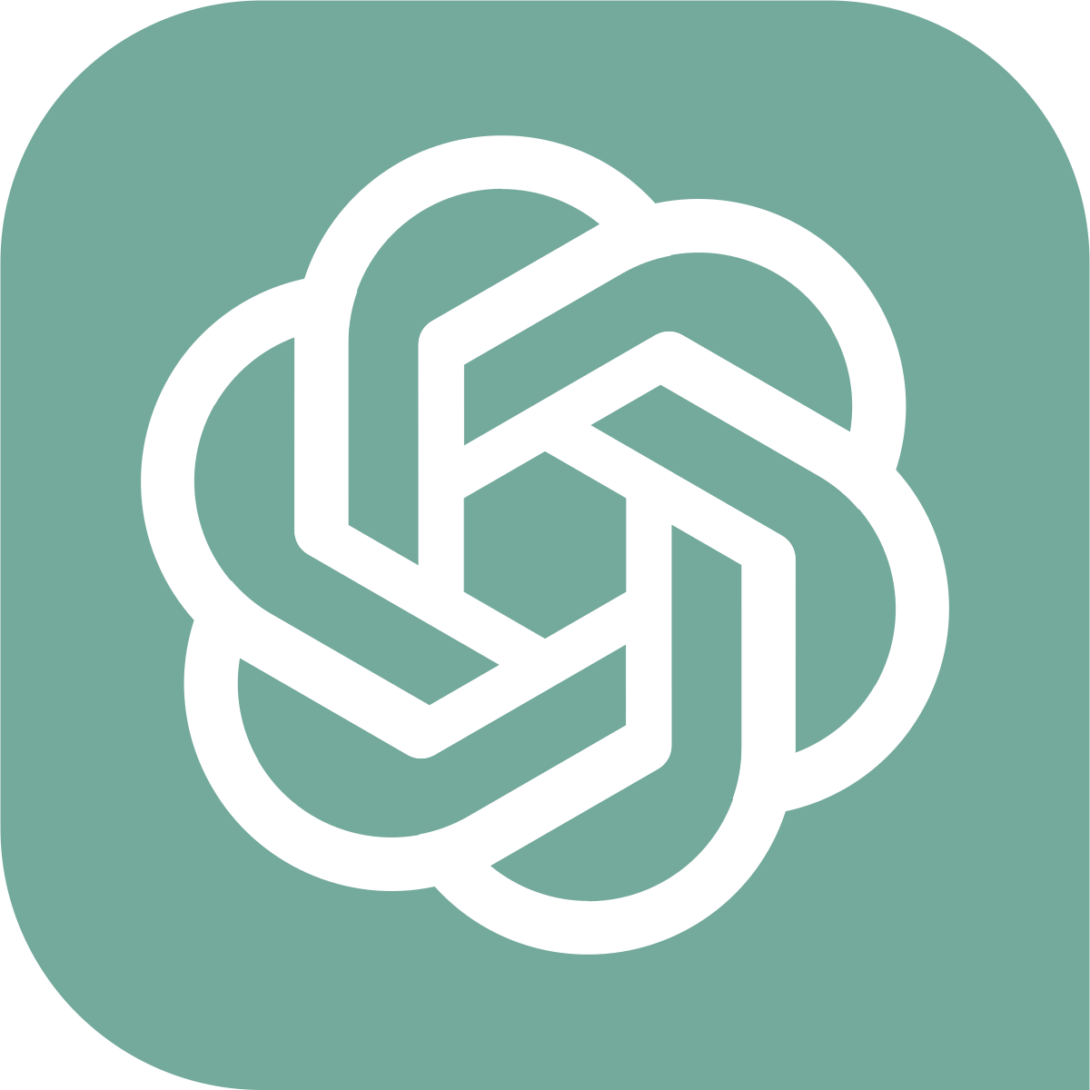Artificial Intelligence

Artificial Intelligence (AI) and Machine Learning (ML) are not new, however the release of ChatGPT in late 2022 prompted a flurry of news media activity, social media posts, and expert testimonials, along with a lot of misinformation about AI and ML, which muddy the waters even more. Here, we try to break down what is most likely important to consider when discussing ChatGPT, other AI tools, ML resources, etc., and potential uses for teaching and learning.
OpenAI is the company that created ChatGPT and they are incrementally releasing new versions of their AI tool and each one is exponentially more powerful than the one before it. OpenAI has been working on this for years, well before most of us of it in late 2022.
You can create a free account to access ChatGPT-3.5 and if you are feeling adventurous, you can pay for ChatGPT-4 which provides faster access to the tools and early access to enhancements. Note that Microsoft Bing AI is built on GPT-4 architecture and is free to use. The GPT part of ChatGPT means generative pre-trained transformer. It is a large language model (LLM), which consists of a neural network with billions + parameters. It's trained on large amounts of unlabeled text and uses self-supervised learning and semi-supervised learning to perform tasks. We could go down the rabbit hole very easily on this topic. If you want to go down your own Wikipedia rabbit hole on this topic, start here: https://en.wikipedia.org/wiki/Generative_artificial_intelligence.
Guidance from the Experts Heading link
The U.S. Government (Office of Educational Technology) released a report in May 2023 called Artificial Intelligence and the Future of Teaching and Learning: Insights and Recommendations (and can be read online here: https://www2.ed.gov/documents/ai-report/ai-report.pdf). One of my colleagues here at UIC, Dr. Szymon Majachewski, summarized the U. S. Government’s report on AI this way:
Key Takeaways
- Al systems and tools must minimize bias, promote fairness, and avoid additional testing time and burden for students and teachers.
- Al systems and tools must account for the context of teaching and learning and must work well in educational practice, given variability in students, teachers, and settings.
- Use of Al systems and tools must be safe and effective for students. They must include algorithmic discrimination protections, protect data privacy, provide notice and explanation, and provide a recourse to humans when problems arise.
- The people most affected by the use of Al in education must be part of the development of the Al model, system, or tool, even if this slows the pace of adoption.
- Policies should focus on the most valuable educational advances while mitigating risks.
- Trust and safeguarding are particularly important in education because we have an obligation to keep students out of harm’s way and safeguard their learning experiences.
Action Items
- Clarify and achieve a consensus on the terms that go beyond data privacy and data security, including ideas like human-centered, value-sensitive, responsible, ethical, and safe.
- Create and study effective programs for Al literacy for students, teachers, and educational constituents in general, including literacy with regard to the ethics and equity issues specific to Al in educational settings.
- Advance research and development to increase fairness, accountability, transparency, and safety in Al systems used in educational settings.
- Define participatory or co-designed research processes that include educators in the development and conduct of research related to the development, use, and efficacy of Al-enabled systems and tools.
- Highlight and advance R&D efforts that empower the participation and voices of youth regarding research, data, and design of Al applications for teaching and learning.
AI for Teaching and Learning Heading link
So, you are interested in using a generative AI tool for teaching and learning? How can we harness the transformative potential of tools like ChatGPT, Bing, Google Bard. Dall-E3 while ensuring that students continue to engage in meaningful cognitive work? The College of Medicine has an AI Task Force that is in the process of suggesting guidelines for student and faculty use of AI for teaching and learning.
The University of Illinois System has developed some guidelines to refer to – these are not specific to the college of medicine. Some highlights from these guidelines:
- Protect (all) data and do not enter proprietary information into AI generation tools.
- Emphasize the strengths and weaknesses of artificial intelligence when talking about it with students.
- Do not trust that results from AI tools are void of error. For example, it is known that many AI systems produce hallucination results, such as citations for scholarly articles that do not exist.
- Promote inclusivity and equality in educational activities that include the use of AI.
- Be mindful that most AI tools require a login to use and some people may be uncomfortable with entering their personal details to access a service.
Teaching with ChatGPT and other Generative AI Tools
Artificial intelligence (AI) tools are ubiquitous and available to both learners and instructors, though not all are free to use and may require you to create a login. Many faculty and administrators are concerned about the impact of these tools on teaching and learning. Questions we have heard include:
- How accurate are these tools?
- What are the limitations of these services?
- Will students be able to generate solutions to assessments using them?
- How will these tools affect academic integrity?
It is important to acknowledge the existence of generative AI tools to your students and articulate your expectations in course syllabi with as much detail as possible. Note: the AI Task Force is generating suggestions for statements to include in syllabi at UICOM. It will be up to the administration, course leaders, and faculty to determine if it is acceptable to use these tools in your courses or assignments and to what degree.
We don’t typically ask students to write papers in our curriculum. However, if you do, it is important to specify what is acceptable in regard to the use of AI to aid in writing or idea generation. It is likely you would not accept a student’s written work that was entirely (or almost entirely) developed by generative AI tools. However, what if 25% was written by it and the rest by a student? Would you accept it then? How would you want them to cite it as a source? Consider including a librarian in your process as they can aid in defining what is acceptable use and help us all to not violate copyright laws.
Promoting Positive Uses of AI in Class with Students
The more explicit and transparent you are about the role of AI technologies in your course as well as your rationale for these decisions, the easier you make it for students to meet your expectations and have a successful learning experience. Here are some possible uses of AI for teaching and learning:
- Idea generation.
- Cleaning up grammar and punctuation (not much different than using Grammarly or Quillbot); UIC will do a pilot of Grammarly in Spring 2024.
- Creating their own case scenarios.
- Prepare for interviews.
Some additional ideas for using AI from CATE: https://teaching.uic.edu/ai-writing-tools/ – includes an example of a critical thinking exercise to evaluate the credibility and reliability of these tools.
How Faculty Can Use Generative AI
With these options below, a word of caution is necessary. Using tools like ChatGPT, the system is set by default to capture your text and store it for future use by other prompts (by you or others around the world). You can turn this setting off. If you have created an account with OpenAI / ChatGPT, navigate to your account settings (lower-left corner as of October 2023), select Data Controls, turn off Chat History & Training.
- Generate case and/or discussion prompts.
- Draft learning objectives.
- Generate glossaries of terms (double-check for accuracy).
- Draft multiple-choice questions.
Further Thoughts
- Guide students in AI exploration and reflection on their experiences with it.
- Encourage students to openly discuss their use of AI tools during the learning process, identifying specific ways they utilized AI to support their inquiry, creation or revision.
- Partner with students to find useful tools and discuss effective and ethical use of them.
- Encourage whole class discussions about the role of AI in education and society, exploring the potential benefits and drawbacks of AI integration. What do students feel is necessary to guard against misuse of AI?
- Consider disclosing your own AI tool usage and explain how it informs your teaching strategies to better promote transparency. Encourage iterative reflection among students — especially amidst team-based learning activities.
- Promote self-regulated learning through metacognitive reflection exercises. Take a process-oriented assessment approach that asks students to document and share their workflow.
- Recognize and value student’s authentic perspectives and original ideas, emphasizing their human creativity and critical thinking skills that emerge separately or alongside the use of AI in the learning process.
Tools You Can Use Heading link
This is not a comprehensive list of tools; it includes tools currently available that may be relevant to your work that you may want to check out.
For a much more comprehensive list, check out There’s an AI for That – almost 8500 AI tools as of October 2023: https://theresanaiforthat.com/. A shorter (& more manageable) list can be found here: https://aiscout.net/
ChatGPT and Other Text-Based Tools Heading link

ChatGPT and Other Text-Based Tools
The most familiar of the AI tools available is ChatGPT, created by OpenAI. However, other companies are quickly closing in & releasing their own versions. OpenAI released a teaching guide in late summer 2023.
- ChatGPT by OpenAI: https://chat.openai.com/
- Google Bard: https://bard.google.com/
- Bing: https://www.bing.com/?/ai
Audio / Video / Images Heading link

Audio / Video / Images
- Adobe Podcast AI: https://podcast.adobe.com/
- This tool is available to UIC faculty, staff, and students to enhance speech, fix microphone issues before recording, and record, edit, and enhance in your browser (the last one may not be included in our UIC Adobe subscription)
- Adobe Firefly: https://firefly.adobe.com/
- Dall-E2: https://openai.com/dall-e-2
- Also developed by OpenAI (but not free as of October 2023), it can create realistic images and art from a description in natural language. Dall-e3 can be found here: https://openai.com/dall-e-3
Further Reading Heading link
Here are some articles and other documentation that might help you as you figure out how to create prompts, whether you are using it for personal use or for teaching and learning. Some of the links below are behind a paywall and you might have to log in with your UIC NETID / password to access.
Chen, B. X. (2023). Get the Best From ChatGPT With These Golden Prompts. Retrieved May 25, 2023, from https://www.proquest.com/docview/2818633452?accountid=14552&parentSessionId=SiZmMRYBgaiRknOALBG4SML028PNWnjvhCPfdDwrp90%3D
Krive, J., Isola, M., Chang, L., Patel, T., Anderson, M., & Sreedhar, R. (2023). Grounded in reality: artificial intelligence in medical education. JAMIA open, 6(2), ooad037. https://doi.org/10.1093/jamiaopen/ooad037
Masters K. (2023). Ethical use of Artificial Intelligence in Health Professions Education: AMEE Guide No. 158. Medical teacher, 45(6), 574–584. https://doi.org/10.1080/0142159X.2023.2186203
Roose, K. (2023, Jan 12). Don’t Ban ChatGPT in Schools. Teach With It. New York Times https://proxy.cc.uic.edu/login?url=https://www.proquest.com/newspapers/don-t-ban-chatgpt-schools-teach-with/docview/2764666131/se-2
Tolsgaard, M. G., Pusic, M. V., Sebok-Syer, S. S., Gin, B., Svendsen, M. B., Syer, M. D., Brydges, R., Cuddy, M. M., & Boscardin, C. K. (2023). The fundamentals of Artificial Intelligence in medical education research: AMEE Guide No. 156. Medical teacher, 45(6), 565–573. https://doi.org/10.1080/0142159X.2023.2180340
van Dis, E. A. M., Bollen, J., Zuidema, W., van Rooij, R., & Bockting, C. L. (2023). ChatGPT: five priorities for research. Nature (London), 614(7947), 224–226. https://doi.org/10.1038/d41586-023-00288-7. https://i-share-uic.primo.exlibrisgroup.com/permalink/01CARLI_UIC/1b4dsmk/cdi_proquest_journals_2775798280
Newsletters
As if you don’t receive enough email, here are some more opportunities.